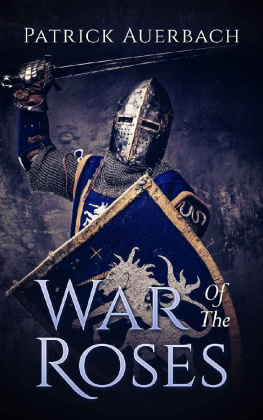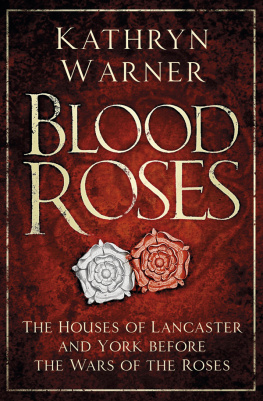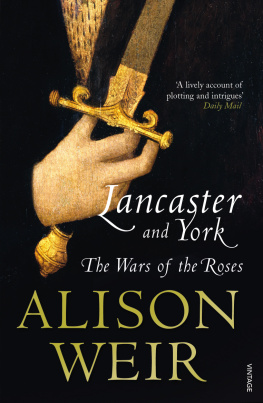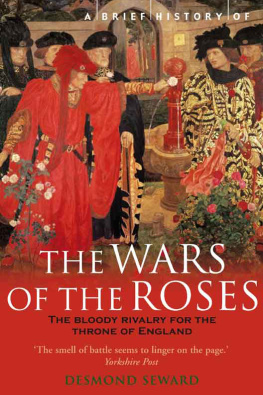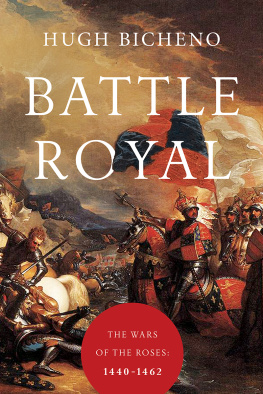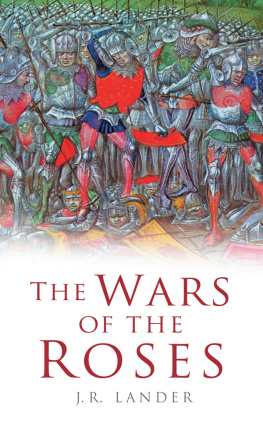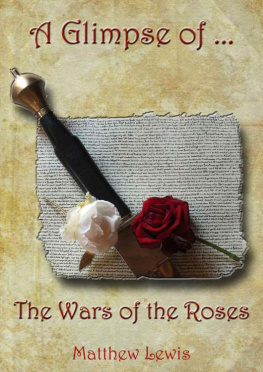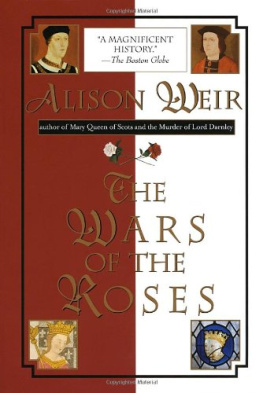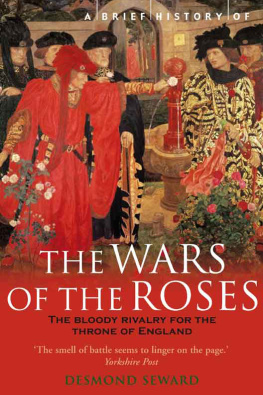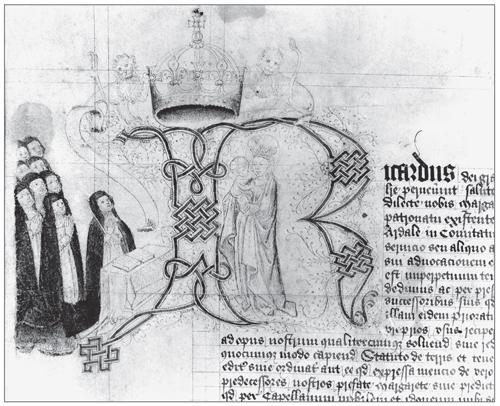For Racer
Detail of an initial letter R which encloses a drawing of the Virgin and Child, surmounted by the royal crown and Yorkist white lion supporters. From the Esholt Priory Charter granted to Margaret Clifford, widow of Lord John, killed at Ferrybridge in 1461.
CONTENTS
This guide stems from a long-held belief that the understanding and enjoyment of history can be enhanced from visiting the actual sites of key historical events and monuments/memorials to people involved in those events. Such visits can complement conventional reading through providing a memorable focus for further study. It has been immensely encouraging to see that in recent years TV documentaries on history now follow the same type of approach, using on-location shots of historic sites associated with the programmes subject matter.
Researching and writing the guide over the past five years has been a labour of love. However, I would not have completed the task without the continuing support of my extended family. Everyone has contributed in their differing ways from lending antiquarian books and advising on matters publishing to explaining the mysteries of digital photography and even joining me on visits. Special thanks must go, however, to my wife, who has provided much-needed encouragement at crucial times.
Many thanks to Rachel, with whom it has been a great pleasure to work again. I must also thank all the vicars, rectors and churchwardens who have kindly shown me round their churches.
All images are from my own collection unless otherwise credited. I am grateful to the following organisations for permission to reproduce images in their collections.
All maps have been drawn by Derek Stone.
College of Arms
Plates I: 2 (top)
Dean and Chapter of Westminster
Plates I: 7 (bottom)
Geoffrey Wheeler
pp. vi, 10, 12, 13, 14 (left), 24, 29, 32, 42, 46, 47, 48, 50, 52, 64, 66, 68, 84, 136, 144, 150, 173, 208, 240, 247; Plates I: pp. 1, 2, 3 (bottom left and right), 4 (bottom left), 5 (top left), 7 (top), 8; Plates II: 2 (bottom), 5 (top right), 6 (bottom right), 7 (bottom), 8 (top left)
Glasgow City Council (Museums)
p. 15 (left)
National Archives
Plates I: p. 6 (top)
Wallace Collection
pp. 14 (right), 15 (right)
This guidebook recommends 260 historic sites and battlefields in England and Wales connected in some way with the Wars of the Roses. I have adopted a rating system (explained ) to assist readers in selecting places to visit. The ratings reflect not only the historical importance of a site or battlefield but also its extent or attractiveness. The ratings given are based on my opinions alone.
TOP-RATED SITES
*****
Canterbury
Fotheringhay
St Georges Chapel, Windsor
The Tower of London
Westminster Abbey
****
Beverley
Britford
Burghfield
Cambridge
Clarendon
Coldridge
Coventry
Gainsborough
Gipping
Leicester
Long Melford
Ludlow
Middleham
Ormskirk
Salisbury
Stony Stratford
Tewkesbury Abbey
Thetford
Warwick
Winchester
Wingfield
TOP-RATED BATTLEFIELDS
+++++
Bosworth
Tewkesbury
Towton
++++
First St Albans
Wakefield
ONE
My interest in the Wars of the Roses goes back many years but really developed following the upsurge in research and books published for the 500th anniversary of the Battle of Bosworth in 1985. Over the years my reading has highlighted that the Wars are incredibly rich in survivals of battle sites, houses, castles, plaques and church monuments. The objective of this guide is to introduce the reader to the best of these by providing for each such surviving site:
A short description of what there is to see.
A brief account of any events in the Wars of the Roses that occurred there and/or biography of the person(s) commemorated, covering his/her role in the Wars. Few battlefields and fewer churches contain any detailed information on this either in a leaflet or with a display notice, but there are exceptions. This guide fills the gap.
Summary directions on how to find the site and other entry details. These directions are designed to complement modern road atlases.
A broad-brush star rating.
The guide covers the 260 sites in England and Wales which I consider to be the most interesting and important for the Wars of the Roses. They occur in virtually every county of England and Wales, showing that although the battles were confined to the central and northern heartlands of England, the conflict was a truly national one. I have visited more than 600 such sites over the last five years, selecting those to visit by consulting recent historical literature (see Bibliography), including the Pevsner and Arthur Mee county guides. My criteria for including sites in the guide are:
There must be something memorable to see to act as a focus of interest. So churches where someone is known to have been buried but where no memorial has survived have been excluded. All the major battles of the Wars are included.
Castles only rarely featured actively in the Wars, except in Northumberland and Wales. However, they still served as the military and domestic headquarters of the aristocracy. Where a castle or manor house was built or substantially rebuilt by a participant in the Wars, it has been included in the guide as a memorial to that person (e.g. Herstmonceux Castle), in addition to any castles that did see major action (e.g. Harlech Castle).
Last, but not least, each site must be accessible to the public.
I have visited all the sites selected for the guide at least once. From the human angle, I have included sites as memorials to people if they fought at least one battle in the Wars or if they were royal or government officials. The biographies of participants have been built up from the same literature, but significantly enhanced by consulting J.C. Wedgwoods parliamentary biographies and Cokaynes The Complete Peerage , together with W.E. Hamptons Memorials of the Wars of the Roses: A Biographical Guide for church memorials.
A real bonus from this exercise is that the 260 selected sites include some of the most beautiful buildings in England and Wales. The fifteenth century saw the flowering of Perpendicular architecture in churches, while brick was just beginning to be used in fortified manor houses and castles. The sites themselves are often in beautiful country as well although some are definitely not! It is worth noting that there are many more sites connected with participants from the final phase of the Wars, between 1483 and 1487. This is probably because of increasing prosperity in the early Tudor years.
The guide also includes a summary of the key dates, the causes and key features of the Wars, together with profiles of their main participants, designed to provide the reader with background for site visits.
Finally a perspective. The main attraction of the Wars of the Roses as a period for historical study is the political and military drama involved. The late Professor Ross wrote, The two years from June 1469May 1471 form a period of political instability without parallel in English history since 1066. However, do not expect to find a full and coherent explanation of all these events in the literature. The Wars took place just before the printed word became widely available, there are few contemporary sources (some of which are written with clear bias) and many later sources were influenced by the Tudor spin machine. The mystery of the Princes in the Tower is well known, but there are others. That is the other attraction of the period it is a crossword with some key clues still missing.


